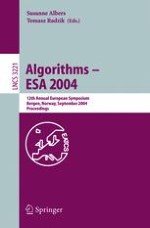2004 | Buch
Algorithms – ESA 2004
12th Annual European Symposium, Bergen, Norway, September 14-17, 2004. Proceedings
herausgegeben von: Susanne Albers, Tomasz Radzik
Verlag: Springer Berlin Heidelberg
Buchreihe : Lecture Notes in Computer Science
Enthalten in: Professional Book Archive
